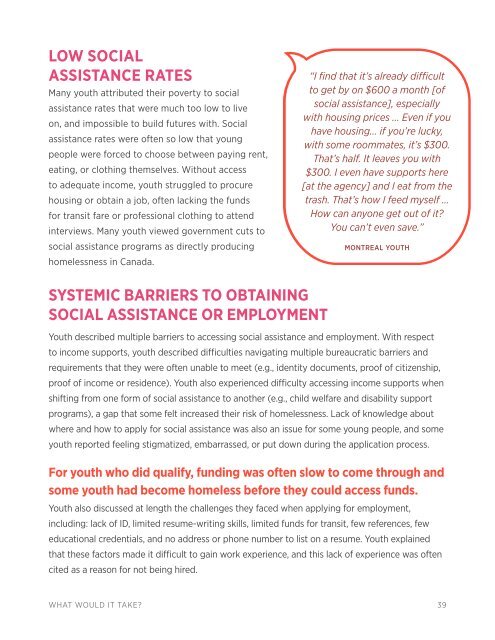COH-AWH-What_Would_it_Take
Create successful ePaper yourself
Turn your PDF publications into a flip-book with our unique Google optimized e-Paper software.
LOW SOCIAL<br />
ASSISTANCE RATES<br />
Many youth attributed their poverty to social<br />
assistance rates that were much too low to live<br />
on, and impossible to build futures w<strong>it</strong>h. Social<br />
assistance rates were often so low that young<br />
people were forced to choose between paying rent,<br />
eating, or clothing themselves. W<strong>it</strong>hout access<br />
to adequate income, youth struggled to procure<br />
housing or obtain a job, often lacking the funds<br />
for trans<strong>it</strong> fare or professional clothing to attend<br />
interviews. Many youth viewed government cuts to<br />
social assistance programs as directly producing<br />
homelessness in Canada.<br />
“I find that <strong>it</strong>’s already difficult<br />
to get by on $600 a month [of<br />
social assistance], especially<br />
w<strong>it</strong>h housing prices ... Even if you<br />
have housing... if you’re lucky,<br />
w<strong>it</strong>h some roommates, <strong>it</strong>’s $300.<br />
That’s half. It leaves you w<strong>it</strong>h<br />
$300. I even have supports here<br />
[at the agency] and I eat from the<br />
trash. That’s how I feed myself …<br />
How can anyone get out of <strong>it</strong>?<br />
You can’t even save.”<br />
MONTREAL YOUTH<br />
SYSTEMIC BARRIERS TO OBTAINING<br />
SOCIAL ASSISTANCE OR EMPLOYMENT<br />
Youth described multiple barriers to accessing social assistance and employment. W<strong>it</strong>h respect<br />
to income supports, youth described difficulties navigating multiple bureaucratic barriers and<br />
requirements that they were often unable to meet (e.g., ident<strong>it</strong>y documents, proof of c<strong>it</strong>izenship,<br />
proof of income or residence). Youth also experienced difficulty accessing income supports when<br />
shifting from one form of social assistance to another (e.g., child welfare and disabil<strong>it</strong>y support<br />
programs), a gap that some felt increased their risk of homelessness. Lack of knowledge about<br />
where and how to apply for social assistance was also an issue for some young people, and some<br />
youth reported feeling stigmatized, embarrassed, or put down during the application process.<br />
For youth who did qualify, funding was often slow to come through and<br />
some youth had become homeless before they could access funds.<br />
Youth also discussed at length the challenges they faced when applying for employment,<br />
including: lack of ID, lim<strong>it</strong>ed resume-wr<strong>it</strong>ing skills, lim<strong>it</strong>ed funds for trans<strong>it</strong>, few references, few<br />
educational credentials, and no address or phone number to list on a resume. Youth explained<br />
that these factors made <strong>it</strong> difficult to gain work experience, and this lack of experience was often<br />
c<strong>it</strong>ed as a reason for not being hired.<br />
WHAT WOULD IT TAKE? 39
















